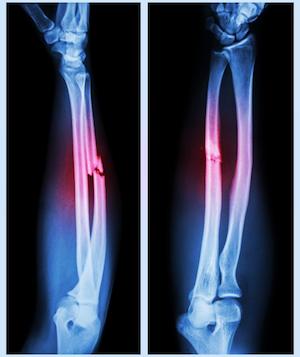Arms Fractures Due to Injury Accidents
Naperville, IL Injury Attorneys for Broken Arms
What is an Arm Fracture?

The humerus, radius, and ulna are the three bones that construct the arm. The humerus is located in the upper arm between the shoulder and the elbow. The radius and ulna are located in the forearm between the elbow and wrist. When standing in an anatomical position (arms at your side with your palms facing forward) the ulna is the bone located closest to the body and the radius is the bone located closest to the thumb. A fracture to any one or more of these three bones is classified as an arm fracture. Arm fractures can be painful and can limit mobility at the shoulder, elbow, or wrist joints, affecting your ability to perform work and daily activities. Arm fractures are extremely common and account for nearly half of all fractured bones. If you believe you have fractured your arm, it is important to seek medical attention immediately to receive appropriate treatment and ensure proper healing.
How Does an Arm Fracture Occur?
Falling onto an outstretched hand or elbow is the most common cause of a fractured arm. However, other common causes of a fractured arm include direct blows and trauma from sports-related injuries, motor vehicle accidents, and work accidents.
What is an Arm Fracture Settlement Worth?
The settlement value of a fractured arm may be difficult to determine before reviewing the medical evidence, such as medical records and bills, and having an understanding of the theory of liability. The value of arm fractures can vary from case to case, depending on the type of arm fracture that occurred, the severity of the fracture, the likelihood of permanency, and the treatment provided. Generally, damages for past and future pain and suffering, loss of a normal life, past and future medical bills, and wage loss can be obtained in an arm fracture settlement. However, an arm fracture injury settlement can be diminished based on whether a plaintiff’s own negligence (or “comparative fault”) contributed to the injury, or when there are pre-existing medical conditions that may also have led to the injury or need for treatment.
Some of Our Firm’s Recent Arm Fracture Settlements
Premises liability, negligence. DuPage County. Settlement for $325,000 was reached on behalf of a balcony collapse victim. As a result of the balcony collapse, the victim suffered a left arm fracture. The case was settled at mediation, after Mr. Malm worked with a structural engineer to prove that the balcony structure was incapable of supporting moderate weight loads.
Premises liability, negligence. Cook County. Settlement for $175,000 was reached on behalf of a client who slipped and fell on a wet, laminate floor in a restaurant. The woman suffered a comminuted fracture of the distal radial metaphysis/epiphysis. Settlement was reached at a mediation between the victim and the restaurant.
Motor vehicle accident, negligence. DuPage County, Illinois. Settlement for $100,000 was reached on behalf of a victim of a T-bone accident. As a result of the motor vehicle accident, the victim suffered a comminuted fracture of the distal radius with displacement and impaction. The car accident claim was settled with the at-fault party’s insurance carrier, State Farm Insurance Company.
What are the Symptoms of an Arm Fracture?
Symptoms of an arm fracture may vary depending on the severity, location, and type of fracture. Signs and symptoms that can accompany an arm fracture include:
- Severe pain
- Tenderness
- Swelling
- Bruising
- Deformity, such as a bent arm or wrist
- A snap or grinding noise at the time of injury
- Limited range of motion at the wrist, elbow, or shoulder joint (depending on the type and location of the fracture)
- The affected arm may appear shorter due to displacement of the fracture bone
- Numbness, tingling, or weakness may be experienced if the fracture causes nerve damage
- Bleeding due to laceration of the skin (caused by compound/open fractures)
How is an Arm Fracture Diagnosed?
Initially, your physician will conduct a physical examination of your arm. During the physical exam your physician will visually inspect your arm for signs and symptoms of an arm fracture such as swelling, bruising, and deformities. Your physician will then proceed to palpate your arm, noting any abnormalities, and will perform a neurovascular assessment to look for any damage to the blood vessels and/or nerves in the arm that might have occurred during the fracture. After the physical exam, your physician will likely order an X-ray imaging test to determine the location and type of fracture. X-rays are the most common and widely available diagnostic imaging technique used to confirm a bone fracture. However, your physician may recommend more detailed images using a computerized tomography scan (CT scan) or magnetic resonance imaging (MRI). A computerized tomography scan and magnetic resonance imaging can help your physician identify more subtle fractures and assess injuries to the surrounding soft tissues.
Types of Arm Fractures

There are many types of arm fractures. The fractured bone may remain in anatomical alignment (non-displaced fracture), shift out of anatomical alignment (displaced fracture), or break into several pieces (comminuted fracture). The skin at the fracture site may remain intact (closed fracture) or the bone may puncture through the skin (open fracture). The fracture may also be a complete fracture, causing the bone to be separated into two or more pieces, or an incomplete fracture, where there is a partial break, but the bone remains in one piece. Fractures are typically classified based on the following:
Location: The humerus, radius, and ulna are divided into three segments: proximal, middle, and distal. A fracture can be partly classified based on its location in one of these segments of the bone. For example, a fracture in the humerus that is closer to the shoulder joint would be classified as a fracture in the proximal end and a fracture closer to the elbow joint would be classified as a fracture in the distal end of the humerus.
Pattern: The bone can fracture in different directions such as crosswise, lengthwise, or in the middle. Some examples of this include transverse fractures (the bone breaks in a straight horizontal line), oblique fractures (the bone breaks in an angled line), or spiral fractures (the fracture line encircles the bone like stripes on a candy cane).
Open vs Closed: The fractured bone may have punctured through the skin (open/compound fracture) or the skin around the fracture site remained intact (closed fracture).
Treatments for Arm Fractures
The primary treatment goal for an arm fracture is to ensure proper anatomical alignment of the fractured bone and then immobilize the fractured bone to allow proper healing. The methods used to achieve this will depend on the bone fractured (humerus, radius, or ulna), the location of the fracture (proximal, middle, distal), and the type of fracture (comminuted, open vs closed, displaced vs non-displaced, etc.).
Non-surgical treatment options: If the fractured bone remains in alignment (non-displaced fracture) then a sling, splint, or cast may be applied to achieve immobilization of the arm. If the fracture causes the bone to become misaligned (displaced fracture), then your physician must realign the fractured bone in a process called reduction before a sling, splint, or cast can be applied.
Surgical treatment options: Certain types of fractures require surgical intervention to realign the bone and to maintain alignment of the bone during the healing process. This type of surgical intervention is known as open reduction (realignment of the fractured bone through surgery) and internal fixation (maintaining bone alignment through surgical implants such as pins, screws, metal plates, and stabilizing rods). Open reduction and internal fixation devices may be necessary if you have the following injuries:
- Comminuted fracture (bone is broken into several pieces)
- Displaced fracture (bone is misaligned due to fracture)
- Multiple fractures
- Intra-articular fracture (fracture that extends into a joint)
- Loose bone fragments that could enter a joint
- Damage to the surrounding ligaments, tendons, nerves, or blood vessels
- A fracture that is the result of a crushing accident (compression fracture)
After the cast and/or internal fixation devices are removed, most patients will require rehabilitation exercises and/or physical therapy to reduce stiffness, restore muscle strength, joint motion, and flexibility.
Contact the Naperville Personal Injury Lawyers at The Law Offices of John J. Malm & Associates
The knowledgeable Illinois accident attorneys at John J. Malm & Associates have successfully handled several cases for our clients who have suffered arm fractures. We are a team of experienced Naperville personal injury lawyers who represent individuals and families who have suffered an injury or loss due to an accident. You may be entitled to a substantial settlement if you have been injured. Call our Naperville office at 630-527-4177, or our St. Charles location at 630-524-2323 and speak with Attorney John J. Malm and his team today.









